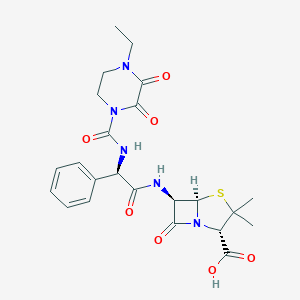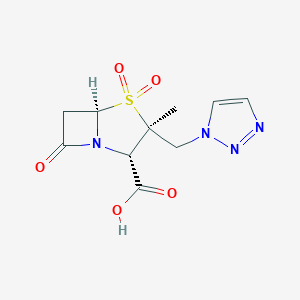Bacterial infection in neutropenic patients
Adult: Piperacillin 2,000 mg and tazobactam 250 mg powder for solution for infusion
Piperacillin 4,000 mg and tazobactam 500 mg powder for solution for infusion
For the treatment of neutropenic patients with signs of infection (e.g. fever): In combination with aminoglycosides: 4,000 mg/500 mg 6 hourly via IV infusion over 30 minutes. Usual treatment duration: 5-14 days. Dose and treatment duration must be based on the severity of infection, pathogen(s), and individual response. Dosage recommendations may vary among individual products and between countries (refer to detailed product guidelines).
Child: Piperacillin 2,000 mg and tazobactam 250 mg powder for solution for infusion
Piperacillin 4,000 mg and tazobactam 500 mg powder for solution for infusion
For the treatment of neutropenic patients with signs of infection (e.g. fever): In combination with aminoglycosides: 2-12 years 80 mg/10 mg/kg 6 hourly via IV infusion over 30 minutes. Max: 4,000 mg/500 mg per dose; >12 years Same as adult dose.
Piperacillin 4,000 mg and tazobactam 500 mg powder for solution for infusion
For the treatment of neutropenic patients with signs of infection (e.g. fever): In combination with aminoglycosides: 4,000 mg/500 mg 6 hourly via IV infusion over 30 minutes. Usual treatment duration: 5-14 days. Dose and treatment duration must be based on the severity of infection, pathogen(s), and individual response. Dosage recommendations may vary among individual products and between countries (refer to detailed product guidelines).
Child: Piperacillin 2,000 mg and tazobactam 250 mg powder for solution for infusion
Piperacillin 4,000 mg and tazobactam 500 mg powder for solution for infusion
For the treatment of neutropenic patients with signs of infection (e.g. fever): In combination with aminoglycosides: 2-12 years 80 mg/10 mg/kg 6 hourly via IV infusion over 30 minutes. Max: 4,000 mg/500 mg per dose; >12 years Same as adult dose.
Intravenous
Hospital-acquired pneumonia
Adult: Piperacillin 2,000 mg and tazobactam 250 mg powder for solution for infusion
Piperacillin 3,000 mg and tazobactam 375 mg powder for solution for infusion
Piperacillin 4,000 mg and tazobactam 500 mg powder for solution for infusion
Usual dose: 4,000 mg/500 mg 6 hourly or 3,000 mg/375 mg 6 hourly via IV infusion over 30 minutes. Usual treatment duration: 5-14 days. Dose and treatment duration must be based on the severity of infection, pathogen(s), and individual response. Use in combination with aminoglycosides is recommended for cases caused by Pseudomonas aeruginosa. Dosage recommendations may vary among individual products and between countries (refer to detailed product guidelines).
Child: Piperacillin 2,000 mg and tazobactam 250 mg powder for solution for infusion
Piperacillin 3,000 mg and tazobactam 375 mg powder for solution for infusion
Piperacillin 4,000 mg and tazobactam 500 mg powder for solution for infusion
2-9 months 80 mg/10 mg/kg 6 hourly via IV infusion over 30 minutes; >9 months weighing ≤40 kg: 100 mg/12.5 mg/kg 6 hourly via IV infusion over 30 minutes; >40 kg: Same as adult dose. Dose and treatment duration must be based on the severity of infection, pathogen(s), and individual response. Dosage recommendations may vary among individual products and between countries (refer to detailed product guidelines).
Piperacillin 3,000 mg and tazobactam 375 mg powder for solution for infusion
Piperacillin 4,000 mg and tazobactam 500 mg powder for solution for infusion
Usual dose: 4,000 mg/500 mg 6 hourly or 3,000 mg/375 mg 6 hourly via IV infusion over 30 minutes. Usual treatment duration: 5-14 days. Dose and treatment duration must be based on the severity of infection, pathogen(s), and individual response. Use in combination with aminoglycosides is recommended for cases caused by Pseudomonas aeruginosa. Dosage recommendations may vary among individual products and between countries (refer to detailed product guidelines).
Child: Piperacillin 2,000 mg and tazobactam 250 mg powder for solution for infusion
Piperacillin 3,000 mg and tazobactam 375 mg powder for solution for infusion
Piperacillin 4,000 mg and tazobactam 500 mg powder for solution for infusion
2-9 months 80 mg/10 mg/kg 6 hourly via IV infusion over 30 minutes; >9 months weighing ≤40 kg: 100 mg/12.5 mg/kg 6 hourly via IV infusion over 30 minutes; >40 kg: Same as adult dose. Dose and treatment duration must be based on the severity of infection, pathogen(s), and individual response. Dosage recommendations may vary among individual products and between countries (refer to detailed product guidelines).
Intravenous
Complicated skin and skin structure infections, Complicated urinary tract infections, Uncomplicated skin and skin structure infections, Uncomplicated urinary tract infections
Adult: Piperacillin 2,000 mg and tazobactam 250 mg powder for solution for infusion
Piperacillin 3,000 mg and tazobactam 375 mg powder for solution for infusion
Piperacillin 4,000 mg and tazobactam 500 mg powder for solution for infusion
Usual dose: 4,000 mg/500 mg 8 hourly or 3,000 mg/375 mg 6 hourly via IV infusion over 30 minutes. Usual treatment duration: 5-14 days. Dose and treatment duration must be based on the severity of infection, pathogen(s), and individual response. Dosage recommendations may vary among individual products and between countries (refer to detailed product guidelines).
Piperacillin 3,000 mg and tazobactam 375 mg powder for solution for infusion
Piperacillin 4,000 mg and tazobactam 500 mg powder for solution for infusion
Usual dose: 4,000 mg/500 mg 8 hourly or 3,000 mg/375 mg 6 hourly via IV infusion over 30 minutes. Usual treatment duration: 5-14 days. Dose and treatment duration must be based on the severity of infection, pathogen(s), and individual response. Dosage recommendations may vary among individual products and between countries (refer to detailed product guidelines).
Intravenous
Complicated intra-abdominal infections
Adult: Piperacillin 2,000 mg and tazobactam 250 mg powder for solution for infusion
Piperacillin 3,000 mg and tazobactam 375 mg powder for solution for infusion
Piperacillin 4,000 mg and tazobactam 500 mg powder for solution for infusion
Usual dose: 4,000 mg/500 mg 8 hourly or 3,000 mg/375 mg 6 hourly via IV infusion over 30 minutes. Usual treatment duration: 5-14 days. Dose and treatment duration must be based on the severity of infection, pathogen(s), and individual response. Dosage recommendations may vary among individual products and between countries (refer to detailed product guidelines).
Child: Piperacillin 2,000 mg and tazobactam 250 mg powder for solution for infusion
Piperacillin 3,000 mg and tazobactam 375 mg powder for solution for infusion
Piperacillin 4,000 mg and tazobactam 500 mg powder for solution for infusion
2-9 months For appendicitis and/or peritonitis: 80 mg/10 mg/kg 8 hourly via IV infusion over 30 minutes; >9 months For appendicitis and/or peritonitis: ≤40 kg: 100 mg/12.5 mg/kg 8 hourly via IV infusion over 30 minutes; >40 kg: Same as adult dose. Alternatively, 2-12 years 100 mg/12.5 mg/kg 8 hourly via IV infusion over 30 minutes. Max: 4,000 mg/500 mg per dose; >12 years Same as adult dose. Dose and treatment duration must be based on the severity of infection, pathogen(s), and individual response. Dosage recommendations may vary among individual products and between countries (refer to detailed product guidelines).
Piperacillin 3,000 mg and tazobactam 375 mg powder for solution for infusion
Piperacillin 4,000 mg and tazobactam 500 mg powder for solution for infusion
Usual dose: 4,000 mg/500 mg 8 hourly or 3,000 mg/375 mg 6 hourly via IV infusion over 30 minutes. Usual treatment duration: 5-14 days. Dose and treatment duration must be based on the severity of infection, pathogen(s), and individual response. Dosage recommendations may vary among individual products and between countries (refer to detailed product guidelines).
Child: Piperacillin 2,000 mg and tazobactam 250 mg powder for solution for infusion
Piperacillin 3,000 mg and tazobactam 375 mg powder for solution for infusion
Piperacillin 4,000 mg and tazobactam 500 mg powder for solution for infusion
2-9 months For appendicitis and/or peritonitis: 80 mg/10 mg/kg 8 hourly via IV infusion over 30 minutes; >9 months For appendicitis and/or peritonitis: ≤40 kg: 100 mg/12.5 mg/kg 8 hourly via IV infusion over 30 minutes; >40 kg: Same as adult dose. Alternatively, 2-12 years 100 mg/12.5 mg/kg 8 hourly via IV infusion over 30 minutes. Max: 4,000 mg/500 mg per dose; >12 years Same as adult dose. Dose and treatment duration must be based on the severity of infection, pathogen(s), and individual response. Dosage recommendations may vary among individual products and between countries (refer to detailed product guidelines).




 Sign Out
Sign Out





